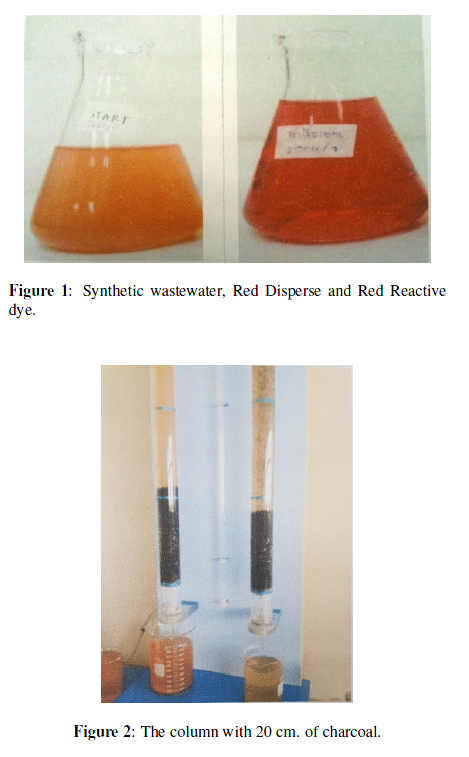Effciency of activated carbon and white charcoal from textile dyeing industry in synthetic wastewater
Main Article Content
Abstract
The experiment aimed on the treatment of synthetic wastewater of disperse dye and reactive dye with activated carbon and white charcoal by wastewater shell that flow through the column. It contained small pellet of charcoal, having thickness 20, 40 and 60 cm, respectively and measured the treatment effciency of dye color every hours and chemical oxygen demand (COD) before and after treatment. The study observed the effciency of white charcoal treatment through that synthetic wastewater treatment of disperse dye having thickness of 20, 40 and 60 cm. The effciency was 62.97%, 50.18% and 89.22%, respectively and activated carbon was 36.88%, 40.77% and 62.38%, respectively. While in case of reactive dye the effciency of white charcoal was 14.85%, 42.47% and 99.94%, respectively and activated carbon was 13.12%, 35.46% and 53.78%, respectively. The treatment of COD found that white charcoal and activated carbon were 71.09% and 58.79%, respectively. Effciency of both dye color and COD treatment increased with increase in the thickness of charcoal. The thickness of 60 cm was better than 40 and 20 cm.
Article Details
References
T. Jantara, The textile industry of Thailand in the future, Avail-able online in October 28, 2017, Available from: http://www.oie.go.th/sites/default/files/attachments/article/TextileIndustryintheFuture.pdf
Pollution problems from the textile industry, Available onlinein October 28, 2017, Available from: http://www.thaiwasteexchange.net/knowledge/pdf/file2132f3b4beee96ba0500dfdd069d2ffe.pdf
K. Hathaisamit, S. Teekasap, Wastewater management of textile industry by TiO2 film, Journal of Vocational and Technical Education, 1(2) (2011) 4 – 10.
W. Chooaksorn, Color removal technology in industrail wastes water, Burapha Science Journal 17(1) (2012) 181 – 191.
U. Singh, R. K. Kaushal, Treatment of wastewater with lost costadsorbent (review), VSRD International Journal of Technical &Non-Technical Research 4(3) (2013) 33 – 42.
D. Sun, Z. Zhang, M. Wang, Y. Wu, Adsorption of reactive dyes on activated carbon developed from enteromorpha prolif-era, American Journal of Analytical Chemistry 3(4) (2013) 17– 26.
P. N. Palanisamy, A. Agalya, P. Sivakumar, Equilibrium up take and adsorption dynamics for the removal of reactive dyes from aqueous solution using activated carbon prepared from Euphorbia tirucalli L wood, Indian Journal of Chemical Technology 20(2013) 245 – 251.
G. O. El-Sayed, M. E. Moustafa, M. F. Mahrous, Removal of disperse 2BLN dye from industrial water onto activated carbon prepared from sugar can stalks, International Journal ofChemTech Research, 3(3) (2011) 1604 – 1611.
APHA., Standard Methods for the Examination of Water and Wastewater, 19th ed. Washington DC: American Public Health Association, 1995.
N. Sinsangkaew, A. Kumsopa, A. Sungpet, P. Prayoonyong,Dyes treatment by adsorption using soybean meal, in The 19th National Graduate Research Conference, Rajamangala University of Technology Isan, Nakhon Ratchasima, Thailand, December 23-24, 2011, pp. 235 – 240.
A. A. Ahmad, B. H. Hameed, Reduction of COD and color of dyeing effluent from a cotton textile mill by adsorption on to bamboo-based activated carbon, Journal of Hazardous Materials, 172(2-3) (2009) 1538 – 1543.
R. Jain, S. Sikarwar, Removal of hazardous dye congo red from waste material, Journal of Hazardous Materials 152(3)(2008) 942 – 948.
P. Setha, Industrial color wastewater treatment by activated carbon, Master’s thesis, Graduate School, Chulalongkorn University, 2000.
S. Iampee, Wastewater Romoval of Color Industry by Activated Carbon Adsorption, Master’s thesis, Graduate School, Kasetsart University, 2001.


